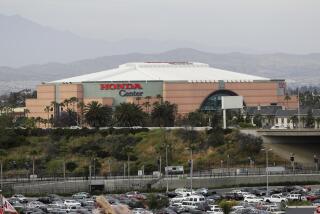GM ‘Orders’ Its Joint Venture to Boost Output : Seeks to Assure That All Chevy Dealers Get Novas
- Share via
DETROIT — General Motors has pressured New United Motor Manufacturing, GM’s joint venture with Toyota, to increase its auto-production schedule for 1985 by nearly 35% in order to get the venture’s new small cars into the hands of all 5,200 Chevrolet dealers before the end of the year, Chevrolet officials said Monday.
Chevrolet General Manager Robert D. Burger said at a Detroit press conference that the GM division had been “disappointed” by the joint venture’s initial plan to produce just 43,000 Nova models this year at its plant in Fremont, Calif.
The venture, which built its first cars last December, has been overly cautious in its plans to gear up to full production, Burger said, forcing Chevrolet to limit this week’s introduction of the Nova to the central United States. But, after GM pushed the joint venture to accelerate production, New United complied by increasing its schedules beginning in the second quarter, Burger said.
Now, the joint venture expects to build 58,000 units this year, and Chevrolet has moved up its nationwide introduction and distribution of the Nova from early 1986 to September or October, 1985, Burger added.
At the Chicago Auto Show in February, Burger had complained that the supply of Novas was so limited that Chevrolet would not be able to introduce the cars on the East and West coasts until next year.
The venture “had been very conservative in their scheduling, and so we put a lot of pressure on them,” Burger said Monday.
Different Approaches
The GM push to speed up production at Fremont underscores a basic difference between the U.S. and Japanese auto industries in their approaches to manufacturing new products, Burger noted. Traditionally, American auto makers optimistically promise their dealers that they will all have an adequate supply of new cars by a preset introduction date, while the Japanese tend to set more pessimistic initial production goals and are less concerned about immediate nationwide availability for new cars, Burger observed.
Meanwhile, Chevrolet has also accelerated its plans for the start of nationwide distribution of its two new Japanese-built small cars, the Chevy Sprint and Spectrum models. GM began selling both cars last year but, because of strict quotas on Japanese imports, hasn’t had enough of either model to distribute them on a nationwide basis.
As a result, Chevrolet has only offered the Suzuki-built Sprint minicar on the West Coast since its introduction in May, 1984, while it has limited sales of the Isuzu-produced Spectrum subcompact to the Eastern United States since its U.S. introduction last November.
But the Japanese government has dramatically increased the number of cars that GM can import from its Japanese affiliates over the next year, allowing Chevrolet to begin nationwide sales of its small imports this fall at the same time that the Nova becomes available throughout the country.
Thomas McDaniel, director of international marketing programs for Chevrolet, said Chevrolet will be allowed to import about 60,000 Sprints between April 1, 1985, and March 31, 1986, and about 90,000 Spectrums during the same period. Last year, by contrast, Chevrolet was allocated only 17,000 Sprints and 29,500 Spectrums.
The Toyota-designed Nova, which is being formally introduced in 25 central states on Thursday, will have a base price of $7,195, Chevrolet officials said Monday. And, while the Nova is the only one of Chevrolet’s three Japanese-based products being assembled in the United States, Burger revealed that 70% of the parts and material used in the car--including the engine and power train--will be imported from Japan.
GM officials have repeatedly promised that the car will have 50% domestic content, but McDaniel said Monday that the 50% level will only be reached by including the value of American labor used in the assembly process at Fremont.
More to Read
Inside the business of entertainment
The Wide Shot brings you news, analysis and insights on everything from streaming wars to production — and what it all means for the future.
You may occasionally receive promotional content from the Los Angeles Times.










